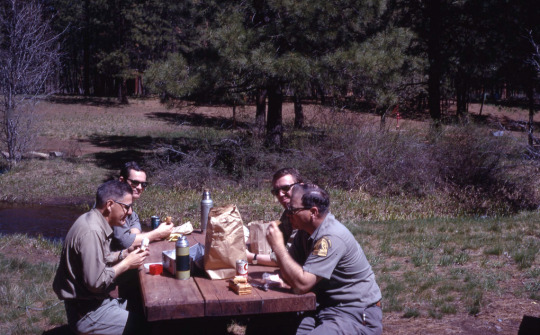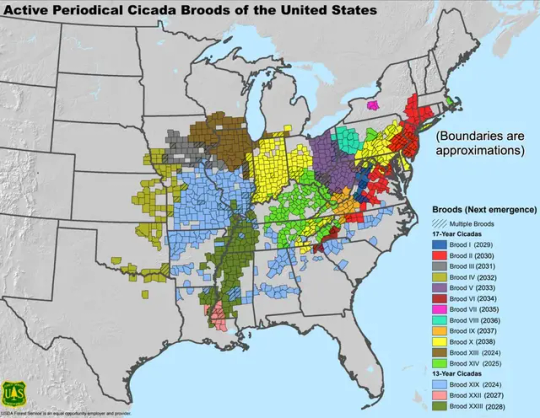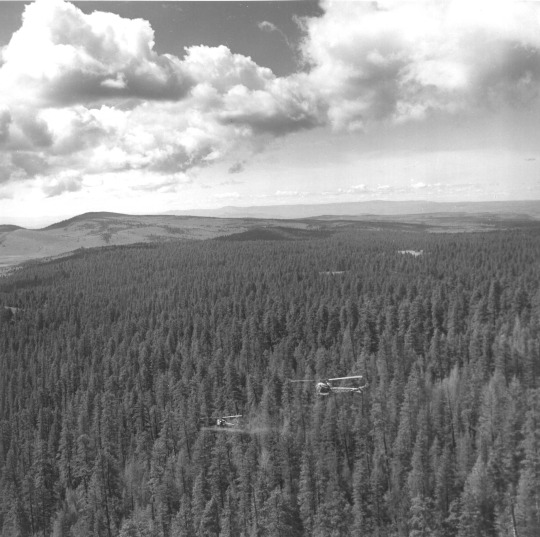#USDA Forest Service
Explore tagged Tumblr posts
Text

The Appalachian grizzled skipper sounds tough because it is. This rare butterfly species occurs in south-facing shale barrens and ridges, which can be some of the hottest and driest habitats in the Northeast.
Photo by USDA Forest Service
31 notes
·
View notes
Text
PROVISIONAL PROGRAMME - Celebration of the International Day of Forests 2024.

On March 21st, from 10:00 am to 1:00 pm, at the United Nations Trusteeship Council chamber, New York;
- OPENING SESSION - Opening remarks: Ms. Juliette Biao, Director, UN Forum on Forests Secretariat H.E. Ambassador Paula Narváez, President of the UN Economic and Social Council H.E. Ambassador Zéphyrin Maniratanga, Chair of the UNFF19 Bureau Mr. Li Junhua, Under-Secretary-General, DESA - PANEL SESSION - Chair: Ms. Leticia Zamora Zumbado, Vice-Chair of the UNFF19 Bureau Mr. QU Guangzhou, Director, FAO Liaison Office, New York Speaker tba, USDA Forest Service Ms. Anna Rathmann, Executive Director, Jane Goodall Institute Speaker tba, International Forestry Students’ Association Mr. Derek Nighbor, President and CEO of the Forest Products Association of Canada Mr. José Carlos da Fonseca, Executive Director, The Brazilian Tree Industry (Ibá) Mr. Kai Lintunen, Head of International Communication, Finnish Forest Association - GENERAL DISCUSSION- Chair: Mr. Javad Momeni, Vice-Chair of the UNFF19 Bureau Statements by Member States, UN entities and other accredited IGOs and Major Groups FOREST VIDEO SHOWCASE Short films from FAO and the 2024 World Wildlife Day Film Showcase (CITES and Jackson Wild) Forests and innovation – new solutions for a better world How Old Cell Phones Are Protecting the Rainforest This New AI Forensic Tool is Fighting Illegal Logging NASA Joins Jane Goodall to Conserve Chimp Habitats
United Nations Forum on Forests, UNDESA on the International Day of Forests 2024.
#USDA Forest Service#UNFF19 Bureau#United Nations Forum on Forests#International Forestry Students’ Association#Jane Goodall Institute#Forest Products Association of Canada#The Brazilian Tree Industry#Finnish Forest Association#United Nations Economic and Social Council#United Nations Trusteeship Council#international day of forests#21 march#Agenda Programme#panel discussion
0 notes
Text

Remember - only you can prevent forest fires!
#vintage illustration#smokey#wild fires#forest fires#smokey bear#smokey the bear#mascots#u.s. forest service#u.s. department of agriculture#usda#forest service#vintage advertising#ad campaigns#psa#public service announcements
29 notes
·
View notes
Text

USDA Forest Rangers stop for lunch.
Oregon
1969
#vintage camping#campfire light#oregon#usda#forest rangers#forest service#history#outdoors#camping#1960s
314 notes
·
View notes
Text
The Bureau of Land Management recently announced that it will no longer allow the use of “cyanide bombs” on its lands. The M-44 devices are often used to protect livestock from animals like foxes or coyotes.
Several environmental groups lauded the decision, saying it makes public spaces safer for people and animals.
“Cyanide bombs” are baited, spring-loaded traps that release deadly poison into the air when triggered. Wildlife agents – often from the U.S. Department of Agriculture – usually set them to control predators, especially in remote areas.
M-44s killed more than 5,000 animals last year, according to the USDA, and were deployed in 10 states, including Wyoming, New Mexico, Colorado and Nevada.
Colette Adkins, Carnivore Conservation program director at the Center for Biological Diversity, said the devices are dangerous because of their indiscriminate nature.
“Anything that tugs on the spring-loaded device will be sprayed with this deadly poison, whether it's a kid, an endangered species or a target animal like a coyote. They really are just too dangerous to be used in public places,” she said.
This issue made national headlines in 2017 when a “cyanide bomb” killed a family pet and injured a boy in Idaho. Since then, several groups have been petitioning to end the use of M-44s on public lands.
With the BLM’s move, the devices are now banned from all lands administered by the U.S. Interior Department. Still, M-44s are allowed on U.S. Forest Service lands and in some states.
#let wolves live#ecology#enviromentalism#wolves#coyote#foxes#bureau of land management#US department of Agriculture#usda#bs culling#Cyanide bombs#us forest service
4 notes
·
View notes
Video
Salt River Dance par Jeff Goldberg
#USDA#Salt River#Salt River Wild Horses#Landscape#Wildlife#Sonoran Desert#Nature#Forest Service#United States Department of Agriculture#National Forest System#Arizona#Outdoor#Horse#U.S. Forest Service#Tonto National Forest#Mesa#United States#US#flickr
2 notes
·
View notes
Text
Been loving the urban forestry webinars at the USDA website. Wednesday, 1/10/2024, 1 – 2:15pm EST
0 notes
Text







images of hands working by the usda forest service & forest health protection, 1970s.
2K notes
·
View notes
Text

Active Periodical Cicada Broods of the United States
Andrew M. Liebhold, Michael J. Bohne, and Rebecca L. Lilja
USDA Forest Service Northern Research Station and Northeastern Area State & Private Forestry (May 2013)
via: Wayback Machine (archive.org)
196 notes
·
View notes
Text
Good. These things are horrifying for a whole host of reasons. First, it's mind-boggling that the USDA kills as much native wildlife as they do; last year's report showed that they killed over 56,000 (no that's not a typo) coyotes intentionally, over 5,000 of which died via cyanide M-44s. The report lists hundreds of other species, many native, intentionally killed by the USDA, plus a number that were unintentionally killed as well, for a total of 383,731 native wild animals killed by the USDA in 2022.
But M-44s also don't discriminate. Any animal that disturbs one--a pet, livestock, an endangered animal, or a human being--can get a deadly dose of cyanide. They're baited so that animals manipulate them with their mouths, meaning they literally get a mouthful of cyanide.
While the US Forest Service still uses M-44s, they will no longer be used on any Department of the Interior land. Here's hoping the Forest Service will follow suit.
#wildlife#wild animals#animal cruelty#animal welfare#cw animal death#animal death#nature#animals#coyotes#cyanide#poison#environment#conservation#ecology#United States
131 notes
·
View notes
Text


#Gimli#gimli son of gloin#LOTR#Lord of the rings#Smokey the bear#Smokey Bear#bearpoll#bear poll#tumblr tournament#bear poll round one
408 notes
·
View notes
Text
Excerpt from this press release from the U.S. Fish and Wildlife Service:
Today, the U.S. Fish and Wildlife Service announced more than $17 million in funding through the Delaware Watershed Conservation Fund, in partnership with the National Fish and Wildlife Foundation, for 45 conservation projects in the Delaware River watershed. The grants will generate nearly $20.7 million in matching contributions from the grantees, providing a total conservation impact of $38 million.
Funding includes more than $4.7 million from President Biden’s Bipartisan Infrastructure Law for six projects aimed at improving public access, recreational opportunities, and water quality, as well as enhancing shoreline resiliency and critical habitat.
The Delaware River watershed spans parts of Delaware, Pennsylvania, New Jersey and New York — a landscape that encompasses one of the most densely populated urban areas in the nation yet remains 50 percent forested. Four hundred miles of the Delaware River are classified as National Wild and Scenic River, indicating their shorelines remain largely undeveloped but accessible in places by roads. These projects supported by the Delaware Watershed Conservation Fund will benefit the millions of people who rely on the Delaware River and its tributaries by improving habitats, reducing flood risks, improving water quality, and increasing access to natural places.
Multistate: $94,069 for building capacity for dam removals in the Delaware River watershed through trainings and workshops.
Delaware: $500,000 for re-envisioning Rodney Reservoir Park with restored natural spaces to enhance water quality, wildlife habitat and recreation.
New York: $779,306 for reconnecting rivers in the upper Delaware River watershed to enhance brook trout habitat and mitigating flooding.
Pennsylvania: $1.5 million for restoring habitat and increasing equitable access to nature at Franklin Delano Roosevelt Park.
Pennsylvania: $830,400 for improving public safety, access and water quality at Stroud Preserve.
Pennsylvania: $1 million for implementing green stormwater infrastructure projects at four under-served elementary schools in Philadelphia.
The total funding also includes $347,450 from the USDA’s Natural Resources Conservation Service for projects such as collaborative forest management in New York and Pennsylvania. This project, co-funded between the Service and USDA-NRCS, is part of a new federal partnership to support conservation efforts on working lands.
20 notes
·
View notes
Text

Right now real life federal wildland firefighters are fighting 50% reduction in pay. We need them now more than ever.
The Grassroots Wildlife Firefighter Foundation has put together a very easy to use letter to send to your senators to urge them to pass a permanent fix on this pay issue.
If you are American, you can just put your name and address and it will use the template to contact your senators for you!
Let them know that you support a permanent pay fix for Federal WFFs in the next CR or emergency supplemental.
Failing to act could mean that federal firefighters will endure a pay cut of up to 50% of base pay, up to $20,000.
The National Federation of Federal Employees (NFFE) and Grassroots Wildland Firefighters have built this letter campaign to make it easy for you.
PS. You can copy paste this (or things from the petition page) and post them on different platforms to forward! I don’t have instagram or a TikTok platform so those would be great!
#evan buckley#eddie diaz#911#911 abc#9-1-1#buddie#bucktommy#911 on abc#9 1 1#bobby nash#chimney han#hen wilson#maddie buckley#118 firefam#station 118#firefighter#firefighters#petition#911 lone star#lone star#tk strand#chicago fire
19 notes
·
View notes
Text
Trump orders USDA to take down websites referencing climate crisis | Trump administration | The Guardian
#climate crisis#climate change#climate action#climate#conservation#environmentalism#environmental protection#usda#social justice#civil rights#human rights#us politics
3 notes
·
View notes
Text

September 1938, Mt. Baker-Snoqualmie National Forest - US Forest Service. Nymphs and dryads dance before the feast table. Still from motion picture “4,000 GIFTS FROM THE FOREST” (USDA Forest Service photo by Asahel Curtis)
3 notes
·
View notes
Text

1965. Spray helicopters. Burns Douglas-fir tussock moth control project. Oregon.
Credit: USDA Forest Service, Region 6, State and Private Forestry, Forest Health Protection. Collection: Region 6, Forest Health Protection historical files located at the Mt. Hood National Forest in Sandy, Oregon.
Image provided by USDA Forest Service, Pacific Northwest Region, State and Private Forestry, Forest Health Protection: www.fs.usda.gov/main/r6/forest-grasslandhealth
Note: "During the period of June 10 to July 1 , 1965, a total of 65,945 acres were sprayed with DDT for control of early-instar larvae (Perkins and Dolph 1967). Application was by helicopter and at the rate of 0. 75 pound DDT in 1 gallon of fuel oil formulation per acre. Because of public concern at this time about side effects of DDT in the environment, impact of the spray on other resources, including fish, water, soil, forage, and cattle, was evaluated by scientists working independently of the project (Crouch and Perkins 1968, Tarrant et al. 1972). In addition, a small test was made of two other candidate insecticides, Dursban, an organic phosphate, and Zectran, a carbamate." From: Wickman, B.E.; R.R. Mason; and C.G. Thompson. 1973. Major Outbreaks of the Douglas-fir Tussock Moth in Oregon and California. GTR-PNW-5. USDA Forest Service, Pacific Northwest Forest and Range Experiment Station. 18 p. www.fs.fed.us/pnw/pubs/pnw_gtr005.pdf
#oregon#eastern oregon#harneycounty#the great pnw#the old west#oregonoutback#pnw#oregon outback#harney county#burns oregon#helicopter#pesticides
4 notes
·
View notes